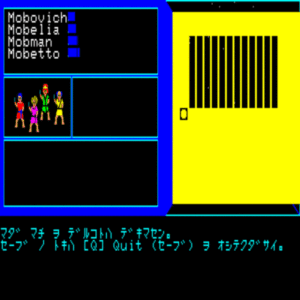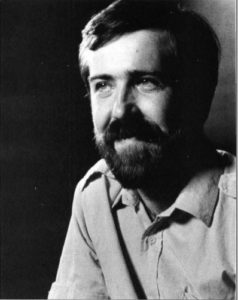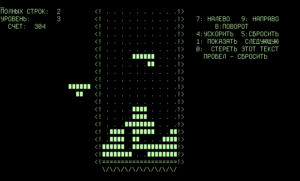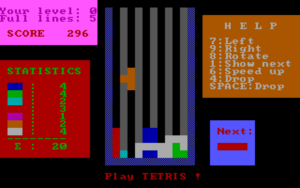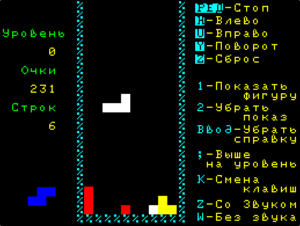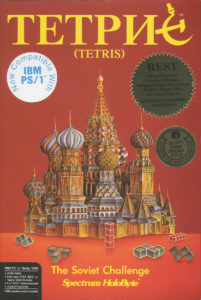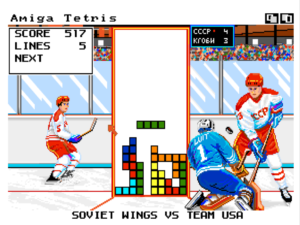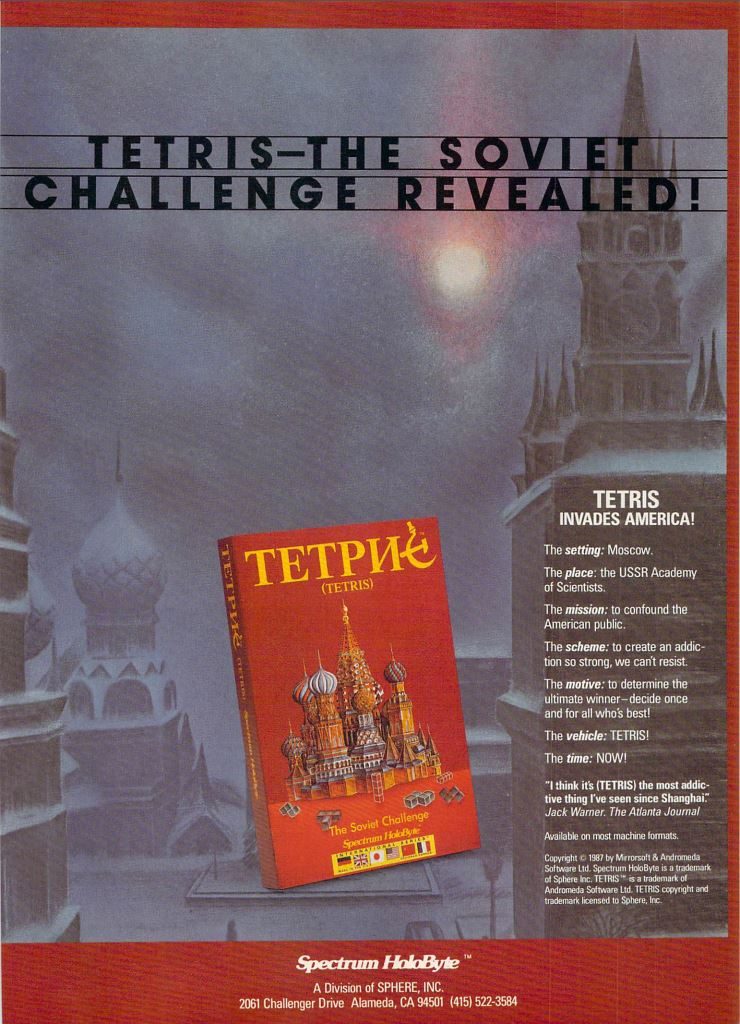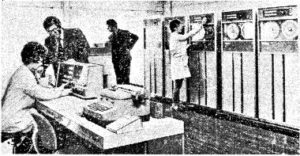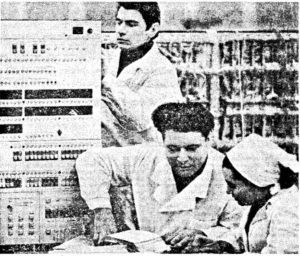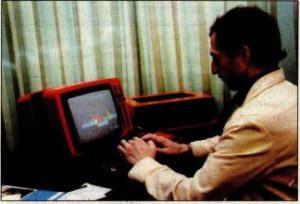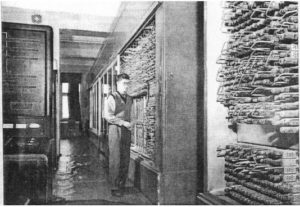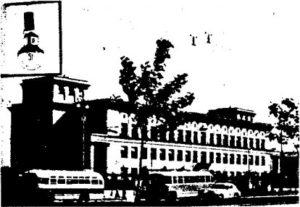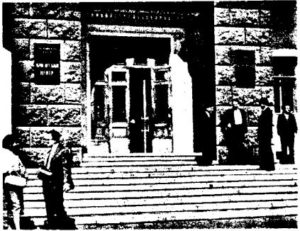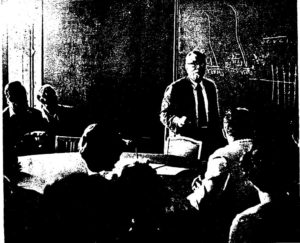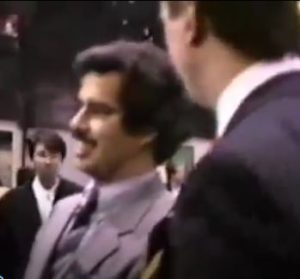
Another day at the office for Henk Rogers: haunting the trade-show circuit, looking for games to license for the Japanese market.
Encompassing three different continents, the story of Henk Rogers’s formative years reads like a preview of the world’s multicultural future. Born in Amsterdam in 1953, Rogers immigrated to New York City when he was 11 years old, courtesy of his mother’s second marriage to an American. He spoke no English at all at the time his family made the move; he could only communicate with his stepfather using their mutual broken German. But Rogers, as he would prove repeatedly throughout his life, was a quick assimilator. Within a year, he was out of his school’s English-as-a-second-language curriculum and into the regular pool of students. And not long after that, he won admission to New York’s Stuyvesant High School for gifted kids.
When he was 19, his family was uprooted again, when his stepfather shifted the center of his business as an importer and exporter of gemstones from New York City to Yokohama, Japan. Not excited about the prospect of another new culture and new language, Rogers wound up in Hawaii as a compromise destination; it would be, relatively speaking, easier for his parents to keep an eye on him there than if he remained on the mainland. In Hawaii, he attended university on and off between working odd jobs. But his real passions were surfing and playing a strange new game called Dungeons & Dragons that was being passed among residents of this far-flung outpost of its home country in the form of dog-eared photocopies. “Some weekends we’d start playing on a Friday evening and wouldn’t stop until Monday morning,” he remembers. “It was a huge part of my life.”
In the meantime, Japan had begun to look more and more attractive after all, thanks to that most eternal of motivations: he had fallen for a Japanese girl studying English in Hawaii. In 1976, he abandoned his own desultory studies to follow her back to her homeland; the couple married the following year. Cut off from his old Dungeons & Dragons buddies, Rogers found both a new hobby and a mode of integrating himself with his new surroundings in the traditional Japanese board game Go. Following the example of his stepfather, whose own passion for Go was so pronounced that Rogers suspected it to be a partial motivation for relocating the family business to Japan in the first place, he would eventually advance to become a six-dan player — just shy of tournament-worthy.
As we’ll soon see, his knowledge of Go would prove unexpectedly valuable later in his life. Right now, though, it certainly wasn’t going to pay the bills. Rogers had always had a somewhat strained relationship with his stepfather, but, cast adrift in Japan with no knowledge of Japanese and no university degree, he had few prospects other than the family business. So, he spent the next six years traveling the world as a gem trader, spending almost as much time in Thailand, a major source of gemstones, as he did in his new home of Japan. In fact, he was there in 1982 when his wife gave birth to the couple’s third child. Dissatisfied alike with travel, gems, and working with his stepfather, he decided after that experience to quit his burgeoning career in gemstones at the age of 29. He was determined to find a more forward-thinking line of work, and one where he could be his own man. In the future, if he missed something as earth-shaking as the birth of a child, it would be by his own election, not his stepfather’s.
From the first time he had encountered a vintage IBM mainframe back in high school, Rogers had had a strong if usually latent interest in computers. Now, using his native charm and family connections, he managed to finagle himself a contract job as a microcomputer programmer at Hitachi. His brief tenure there would set another pattern for his future — that of an aggressive defender of intellectual-property rights. For his first assignment, his superiors, displaying the blissful disregard of copyright law that was so endemic inside even big companies like Hitachi during the early days of the microcomputer industry, asked him to break the protection on a copy of VisiCalc so that it could be shared throughout the company. When Rogers flatly refused to do so on ethical grounds, he was instead asked to create a simple home-accounting program to be sold for Hitachi’s computers. In addition to writing the program, he engineered his own ingenious copy-protection method, using a pair of strong magnets to corrupt certain sectors of the disk. Determined to secure his royalty stream from the ravages of software piracy, he told Hitachi that he would only give them permission to release the program if his copy protection remained on the disk. Hitachi demurred, and that was that for the accounting program and for Henk Rogers’s career as a contract programmer. Luckily, he already saw a brighter prospect on the horizon.
Thanks to his contacts in the United States, Rogers was aware of the phenomenon that was Wizardry, the computerized implementation of the Dungeons & Dragons experience that had taken the Apple II by storm in 1981 and was still selling like crazy a couple of years later. Despite a vibrantly creative culture of arcade games, console games, and (to a somewhat lesser extent) computer games, Japan had nothing remotely like Wizardry. As a Westerner based in Japan and a programmer with a background in Dungeons & Dragons, Rogers realized he was wonderfully positioned to remedy that failing. “I had never built a product,” he says. “I had no idea what I was getting into. But I did have a bold vision for the game: a full Dungeons & Dragons game featuring fighters, warriors, wizards, clerics. All of that stuff.” Over the course of nine months, he programmed a dungeon crawl, heavily derivative of Wizardry but simplified in many ways, on the NEC PC-8801 home computer. The finished product, if it perhaps didn’t quite live up to that first “bold vision” of being everything Dungeons & Dragons was, would prove good enough for his purposes. He called it The Black Onyx, a nod to his old career in the gemstone trade. Unhappy with the deals offered by the established publishers, he formed his own little company, which he named Bullet-Proof Software, to publish the game himself.
Lacking though it was in many ways compared even to the original Wizardry, much less the many CRPGs that had followed the latter game onto the North American market, The Black Onyx was nevertheless the first really playable CRPG to hit Japan, manifesting just enough of the qualities that can make the genre so compelling. Rogers’s biggest problem was figuring out how to market it in a country that had little awareness of Dungeons & Dragons, or for that matter of the Western tradition of epic fantasy in general. He claims that, upon publishing the game via magazine advertisements in December of 1983, he sold just one copy in the first month, four in the second. Desperate for a breakthrough, he hired a translator to alleviate his still-dodgy Japanese and conducted a personal publicity blitz, visiting each of the major Japanese computing and gaming magazines and teaching the staff there how to play a CRPG.
It worked. Each magazine’s April issue ran a long and very positive review, and sales exploded. Soon The Black Onyx was selling 10,000 copies per month and being ported to every viable home computer in Japan. It ended 1984 as the best-selling Japanese computer game of the year, and actually wound up fueling sales of its own inspiration, Wizardry, when the older game was ported to Japanese computers; being more advanced than Rogers’s game, Wizardry was ironically taken to by Japanese players as the logical next step in dungeon crawls. In the longer view, The Black Onyx set the stage for franchises like Dragon Quest and Final Fantasy that are still going strong today. The Japanese would never lose their passion for the genre, although they would soon take it in their own distinct direction. If anything, the CRPG is even more popular today in Japan than in the land of its birth.
The voice of Henk Rogers, however, wouldn’t be a notable one for very long in the craze he had done so much to foment. He hammered out a Black Onyx II to more modest success, but by the time he was starting on a third game it was becoming clear that the series’s reign was destined to be a short one in the face of the competition now entering the market. “I was flattered on one hand,” he says. “But I also realized that I didn’t quite understand the Japanese aesthetic and way. These games were quite different to mine, and just struck a more effective cultural chord.” He never even finished the third game.
While it’s certainly true that Japanese CRPGs would take on their own personality in time, it’s perhaps debatable, given the more sustained success enjoyed by the Wizardry series in Japan, whether The Black Onyx‘s short day in the sun had more to do with cultural factors or fundamental issues of design and implementation. In the final analysis, the game’s success had been at least as much a tribute to Rogers’s skill at personal salesmanship and his talent for straddling cultural divides as a reflection of the rather workmanlike implementation of a dungeon crawl at the root of it all. Tacitly acknowledging this, he now largely abandoned game design in favor of playing to these, his real strengths.
Rogers continued to see opportunity in the cultural divide between the West and Japan, which was in its own way as pronounced as that between the West and the Eastern Bloc. When Western eyes peered toward Japan, they saw a pictographic alphabet even more cryptic than the Cyrillic glyphs found in the Soviet Union, supporting a language lacking any of the Latin antecedents shared by its Western peers. And they saw a culture that could seem almost as impenetrable as the language. What to make of a country where comics full of the most transgressive (to Western sensibilities) forms of sexual violence were everyday fare in family bookshops, yet the incidence of actual sexual violence was one of the lowest in the world? What to make of a country with one of the healthiest diets in the world — resulting in one of the longest average lifespans in the world — that nevertheless took Colonel Sanders of Kentucky Fried Chicken fame to heart as some combination of Santa Claus and minor deity? What to make of a country whose rules of social etiquette were so infamously complex and nuanced that it was doubtful whether any Westerner had ever fully understood them, where an extra inch or lack thereof in a bow could spell the difference between decorum and boorishness? Plenty of Westerners over the years would find this alternate Mirror World as fascinating as the one behind the Iron Curtain, would fall into rabbit holes of Japanophilia from which they would never emerge. Most Western game publishers of the 1980s, however, had enough problems selling games to their own citizens. They had no time to try to figure out what might appeal to those strange people on the other side of the Mirror.
In this ongoing cultural disconnect, Henk Rogers saw opportunity. Just as he had sensed the appeal of a game like Wizardry in Japan, he was convinced that there were plenty of other great game ideas waiting to be imported from the West, and that he was just the person to do the importing. His new life as a game importer took on certain ironic similarities to his old one as an international gemstone trader. He roamed the world, haunting trade shows to check out the latest and greatest games. He looked for games that had commercial potential in Japan, which weren’t always easy to find; in general, games in Japan had a different, simpler aesthetic than the complex simulations and adventure games that dominated much of computer gaming in North America in particular. When he found a game he judged to have potential, he deployed his sheer personableness — by far his greatest asset in business — to more often than not work out a deal with the publisher. He then carried the game with him back to Japan, where he put his handful of programmers to work porting and translating. Bullet-Proof Software wasn’t the only importer and porter of Western games in Japan — a company called StarCraft had been at it since before The Black Onyx had been a gleam in Rogers’s eye — but they were quite successful at it. Among the games they introduced to Japanese audiences were such classics as Archon and M.U.L.E.
But for all the success Rogers was enjoying, the full-fledged computers to which he ported his games made up a very small part of the overall market for digital games in Japan. By the mid-1980s, the heart of the market lay with the Nintendo Famicom console, which would sell a stunning 10 million units in Japan — approximately one for every twelve people living in the country — in its first three and a half years on the market there. By disposition a mainstream rather than a niche sort of guy, Rogers desperately wanted a piece of that action. Unfortunately, Nintendo ruled every aspect of the Famicom, computing’s first great walled garden, with an iron fist. Very few third parties were allowed to make games for the platform, and then only under the strictest of terms. After rejecting the bids of some of the biggest names in consumer electronics, it was difficult to imagine them giving Rogers’s tiny Bullet-Proof Software more than the slightest glance.
Yet Henk Rogers had never been one to take no for an answer. When he learned that Nintendo’s famously imperious president Hiroshi Yamauchi was, like himself, an avid Go player, he saw his opening. He wrote directly to Yamauchi, saying he owned the best computerized Go game in the world — he owned no such thing, but needs must — and was interested in porting it to the Nintendo Famicom. Much to Rogers’s own surprise, Yamauchi invited him to a visit at Nintendo’s headquarters in Kyoto to discuss the proposal. Over a Go board and glasses of Yamauchi’s good Scotch, the two struck a deal that many companies many times the size of Bullet-Proof would have killed to have. Rogers hastily sourced an extant Go computer game from a tiny publisher called Edge Computers in Britain — perhaps not actually the world’s best computerized Go program, but it would do — and had his team port it to the Famicom. It sold 150,000 copies, hardly a spectacular figure by Nintendo standards, but pretty darn great by Bullet-Proof’s. Most importantly, Bullet-Proof was now established as one of the elite circle of developers able to make games for the Famicom. Rogers, still embracing the role of Western gaming’s ambassador to Japan, went off again in search of more games that would work within the technical and cultural constraints of the Japanese Nintendo market.
The two annual Consumer Electronics Shows, the high points of the American games industry’s calendar, were musts for a person in Henk Rogers’s position. Thus it was that he found himself wandering through Spectrum Holobyte’s display at the Winter CES in Las Vegas in January of 1988. Running there was this odd game of falling shapes called Tetris, which was about to be released for computers in Europe and North America. Like Robert Stein before him within the much more austere environs of the Institute of Computer Science in Budapest, Rogers’s initial instinct was to dismiss the game as too simple even for the Nintendo. And yet somehow he kept drifting back over to it. When he finally stepped up to play, he didn’t want to stop. He found that Tetris reminded him of Go in the way it built a well-nigh compulsive experience out of the most basic of raw materials: black and white stones and a grid of tiles in the case of the latter, seven distinct shapes falling endlessly down the screen in that of the former. “Tetris was probably the quietest game at the show,” he remembers. “Even then, products were graphically exciting, but this game was a totally different thing. I wanted to play it because it struck some basic chord. I couldn’t stop playing.”
Tetris was the ultimate find for a games importer like himself: utterly abstract, it carried along with it no cultural baggage whatsoever, wouldn’t really even require any language translation. And thanks to its simplicity it would be dead easy to port like crazy. Rogers decided he had to have Tetris for Japan, and he had to publish it on everything there: Nintendo, home computers, even in the form of standup arcade games if possible. Determined to deliver his patented sales pitch to maximum effect, he invited Phil Adam and Gilman Louie, the partners in charge of Spectrum Holobyte, to visit Japan at his expense to see his operation in action and hopefully make a deal. In May of 1988, a euphoric Rogers secured from them an agreement in principle to license Tetris for the Nintendo Famicom and for Japanese home computers.
But competing interests and miscommunication would combine to make his euphoria short-lived. Robert Stein, you’ll remember, had licensed the rights to Tetris to Mirrorsoft in Britain, who had then brokered a second deal with their semi-sister company Spectrum Holobyte in the United States to sell the game in that market. One problem with all this was that, unbeknownst to his Western partners, Stein had never actually signed a contract with or otherwise gotten clear permission from Alexey Pajitnov and/or the Soviet state to do anything at all with Tetris before Mirrorsoft and Spectrum Holobyte released it; we’ll return to that ticking time bomb in the next article. But a second, subtler potential bombshell also lurked beneath the surface of the deal: it wasn’t at all clear where the rights of Spectrum Holobyte, Mirrorsoft, and Stein’s Andromeda Software began and ended when it came to making further licensing deals involving the game. Before Henk Rogers arrived on the scene, Mirrorsoft, believing themselves to be the senior partner, at least in comparison to Spectrum Holobyte, and thus empowered to make sweeping deals involving the property that affected the American publisher as well, had already sub-licensed it to no less storied a name in videogames than Atari — or, rather, to a subsidiary of Atari called Tengen.
Regular readers of this blog may recall that Atari in the aftermath of the Great Videogame Crash had been split into two entities that were sold off separately by Warner Communications, the company’s brief-lived corporate parent. And just to make things extra confusing, both entities retained the Atari name. Atari Corporation went to Jack Tramiel, the recently deposed head of Commodore. It had jurisdiction over home computers and game consoles. Atari Games went to the Japanese company Namco, a big player in standup arcade games (among other claims to fame, Namco had created Pac-Man). It had jurisdiction over the old Atari’s substantial arcade-game business. Each new Atari was strictly forbidden under the terms of the sales to enter the other’s area of specialization.
At first, Atari Games had reason to believe they had gotten the better end of the bargain. The arcade market had never cratered quite as badly as the console market, and, although it would never enjoy a return of the glory days of the early 1980s, did make a modest recovery from its worst depths in relatively short order. Hideyuki Nakajima, the executive whom Namco had placed in charge of Atari Games, was so bullish about the arcade market that in early 1987 he engineered a stock purchase giving him and a handful of his top employees complete control of the company. Atari Games was now an independent maker of arcade games once again, just as the original company had been back in the days of Pong.
By 1987, however, the Nintendo Famicom had finally come to North America under the name of the Nintendo Entertainment System, and console gaming, just a few years on from being pronounced a dead fad, was exploding once again. A new generation of kids were replacing Pac-Man with Super Mario on their tee shirts and lunch boxes. Jack Tramiel’s Atari Corporation, the only version of Atari with permission to enter the console market, seemed nonplussed by it all, focusing instead on the exercise in diminishing returns that was their ST line of home computers. Atari Games, on the other hand, was positively aching to find a way back into the console market, which soon dwarfed that of the arcades.
Peering closely at the legalese which bound their operations, Atari Games realized that it prohibited them only from entering the console market under the name of Atari. So, they created a subsidiary, peopled with veteran Atari staffers, to make console games under a different name. They called the new subsidiary Tengen Corporation. Ironically in light of the role Tengen would later play as an arch-nemesis of the Go lovers Henk Rogers and Hiroshi Yamauchi, the new name was a reference to the classic Japanese board game — as, for that matter, was the name “Atari” itself, which refered to a perilous position for a Go player roughly equivalent to a check in chess. Go players call the board the universe, and the central spot on it is known as the “tengen.” Thus the new name was a reference to the spot the “new” company hoped to occupy: one at the center of the videogame universe. Placed in charge of achieving that goal for Tengen was Randy Broweleit, late of the computer-game publisher SSI.
The initial strategic plan at Tengen would have them leverage the strengths of the parent company by making home versions of Atari’s latest arcade hits. Such a plan would require them to release their games on the Nintendo, the only truly viable platform in the console market of the time. In January of 1988, days after Henk Rogers first encountered Tetris in Las Vegas, they thus signed a contract with Nintendo. Despite an already palpable tension between the two management teams — the Atari veterans saw Nintendo as usurpers of their rightful crown, and didn’t do a terribly good job of hiding it — Atari’s suite of major arcade properties that were natural candidates for porting to the home made their offer a difficult one for Nintendo to refuse. Still, Nintendo wasn’t interested in making things too easy for them. Under the contract’s terms, Tengen was allowed to make exactly five games per year for the console, a restriction that, although standard boilerplate for Nintendo’s third-party licensees, nevertheless chafed from the get-go.
Yet the restriction didn’t keep them from exploring the possibility of releasing games that had never appeared in an arcade. Shortly after signing the deal with Nintendo, Tengen fell under the thrall of the Tetris Effect when an employee brought a boxed copy of the Spectrum Holobyte release of the game into the office with him. Broweleit couldn’t help but note that the game had far more in common with the simple aesthetic of Nintendo than it did with its more complex peers on computers. He thought it might make a good fit on the console, and passed this recommendation on to Hideyuki Nakajima, the head of Atari Games and thus the man who really called the shots at Tengen.
Following the legal fine print on the back of the box through Spectrum Holobyte, Mirrorsoft, and Andromeda, Nakajima decided to contact the middle of these entities, with whom he already had a relationship thanks to past deals. In lieu of cash, he worked out a straightforward rights swap with a Mirrorsoft executive named Jim Mackonochie: Tengen would get worldwide console rights to Tetris, while Mirrorsoft would get worldwide computer-game rights to Blasteroids, one of Atari’s big arcade releases of the previous year. Seen retrospectively, it wasn’t a very good deal at all from Mirrorsoft’s perspective, given that Tetris would go on to conquer the world while Blasteroids would go down in arcade history as an over-complicated, not-very-fun dog of a game. At the time, though, Mackonochie, one of that minority of players who were immune to the Tetris Effect and who thus saw it as little more than an interesting curiosity, believed he had done very well indeed.
Simultaneously, Atari went directly to Robert Stein to acquire the heretofore unsold arcade rights. Molding Tetris to their normal business model, they planned to release the arcade game first, letting it build name recognition and momentum, then bring it to the Nintendo in 1989.
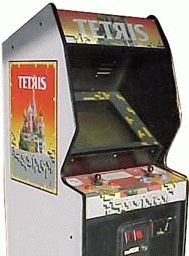
Atari’s arcade version of Tetris, which proved very successful after it started shipping in the summer of 1988. In some ways the forgotten version of Tetris, this is the form in which many players who would later become full-blown addicts on the NES and/or Game Boy first encountered the game. Note that the Russian and Soviet imagery from the Mirrorsoft and Spectrum Holobyte releases is maintained.
Even as Atari was making these deals, Phil Adam and Gilman Louie of Spectrum Holobyte were shaking hands with Henk Rogers over some of the same Tetris rights. When Louie called Mackonochie to tell him about the deal he’d negotiated, and the magnitude of the screw-up became clear, the conversation turned into a shouting match. Something obviously had to give — and Mirrorsoft, who had made the first deal with Robert Stein to license the game and lay much closer to the heart of Robert Maxwell’s publishing empire, was in the stronger position. As a sop, Spectrum Holobyte was allowed to sell the Japanese home-computer rights to Tetris to Rogers. But the Nintendo rights — the ones Rogers really coveted — would go to Tengen. The final contract specifying as much was signed between Mirrorsoft and Tengen on May 30, 1988.
But, as we’ve already had ample occasion to observe, Henk Rogers wasn’t easily denied. If Tengen now owned the console rights to Tetris, he would simply have to get his piece of the action from them instead of from Spectrum Holobyte. He immediately started pleading his case to Hideyuki Nakajima and Randy Broweleit. Being afflicted with the same trepidation about doing business in the Japanese Mirror World that afflicted most American companies, Atari had already flipped the Japanese arcade rights to Sega. Thus that part of Rogers’s Japanese plans for Tetris was a non-starter. But Tengen decided at some point during Rogers’s charm onslaught that there was really no reason not to let this upstart have the Japanese Nintendo rights. Once that deal was made, the rights had reached four degrees of separation from Alexey Pajitnov back in Moscow: they passed through Robert Stein’s Andromeda Software to MirrorSoft, from Mirrorsoft to Tengen/Atari, and finally on to Henk Rogers’s Bullet-Proof Software. The contract which Rogers signed with Tengen reflected this convoluted chain of ownership. It specified that he would have to give a videotape of his Nintendo Tetris to Tengen once it was finished. If it met their standards, they would pass the videotape on to Mirrorsoft, and so on, until it arrived in Moscow for final approval. Happy to jump through whatever hoops were necessary to get his hands on Tetris, Rogers readily agreed, and set his small team of programmers to work. When they were finished, he duly passed the end result up the chain, receiving within a few weeks word from Stein that his Russian charges had given the final stamp of approval.
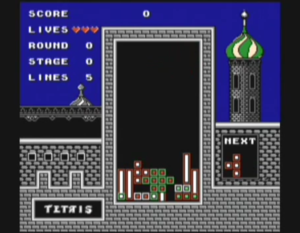
Bullet-Proof’s version of Tetris for the domestic Japanese Nintendo Famicom market. Note that they followed the lead of Vadim Gerasimov in implementing the game in English, and that of Mirrorsoft, Spectrum Holobyte, and Atari in yet again filling it with Russian and Soviet imagery.
Bullet-Proof Software’s home-computer version of Tetris hit the Japanese market in November of 1988, and was a solid success. The Nintendo Famicom version followed in January, and blew up huge, exceeding by an order of magnitude any of Rogers’s previous successes. Indeed, it was in the poetically appropriate alternate Mirror World of Japan that Tetris first became a truly mass-market phenomenon, selling 130,000 copies in its first month on the market — as many as the Mirrorsoft and Spectrum Holobyte releases combined had sold in their first year. It would go on to sell another 2 million copies. Tetris had now circumnavigated the globe from east to west, finding its greatest success to date very nearly back at its original starting point, in a country from which a westward-facing observer could see the Soviet Union on a clear day. Henk Rogers enjoyed vindication for his faith in the game. And he enjoyed the tangible rewards of that vindication: he was suddenly a rich man.
Anyone taking stock of the situation now couldn’t help but acknowledge that Tetris was far more than a niche curiosity. With computer versions having proved successful in North America, Europe, and Japan, with the Nintendo Famicom version having proved very successful in Japan, and with Tetris arcade games eating quarters (or their monetary equivalents) in prodigious fashion all over the world, a North American Nintendo version had to stand front and center in Tengen’s plans for 1989. There seemed little reason to doubt, given the relative size of the markets, that this version would become the most successful yet. Things were beginning to move quickly — perhaps a little too quickly for one Robert Stein, still clinging to his role as the rest of the world’s sole conduit back to the game’s country of origin, still trying to mask how sketchy his relationship with the Russians actually was. Everything that had happened to Tetris since it had escaped through the Iron Curtain had been built on the foundation laid down by Stein. Now everyone was about to discover how shaky that foundation really was.
(Sources: the books Game Over: How Nintendo Conquered the World by David Sheff and The Tetris Effect: The Game That Hypnotized the World by Dan Ackerman; the BBC television documentary From Russia with Love; Computer Gaming World of April 1987; Electronic Games of July 1993; GamePro of December 1990; Game Developer of August 2012; the article “Off the Grid” from the Hawaii Business website.)
